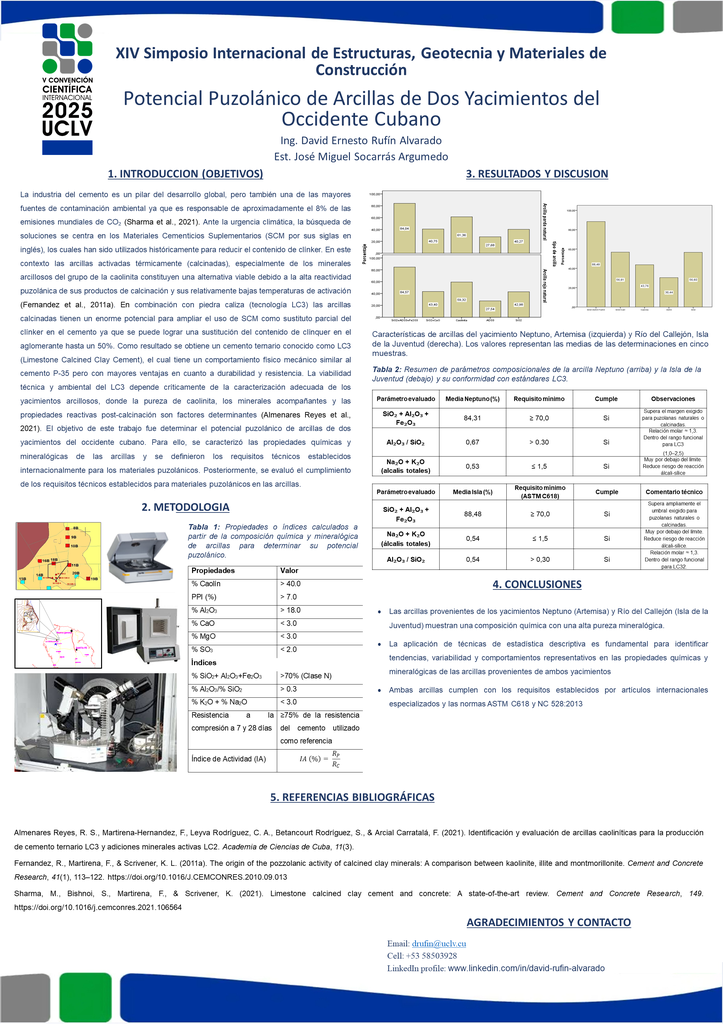Executive Secretary

XIV International Symposium on Structures, Geotechnics and Construction Materials
ESTRUCTURAS 2025
3rd International Workshop on Sustainable Production and Use of Cement and Concrete

Abstract
The cement industry is a pillar of global development, but also one of the largest sources of environmental pollution, accounting for approximately 8 per cent of global CO emissions. In this context, the search for solutions focuses on Supplemental Cementitious Materials (SCM), including thermally activated kaolinitic clays. These constitute a viable alternative due to the high puzolanic reactivity of their calcination products and their low activation temperatures in relation to other materials. The general objective of this work was to determine the puzolanic potential of clays from two deposits in western Cuba for LC3 production. For this purpose, the chemical and mineralogical characteristics of the clays were described. In addition, compliance with internationally established technical requirements for puzolanic materials was assessed and correlations were established between the variables evaluated. As a result, it was verified through the sampling carried out that in the Neptuno deposit, Artemisa the brown and red clays studied showed similar characteristics and met the requirements established above. Among them, the kaolinite content greater than 40 % (59.32 % red clay and 61.36 % brown clay) and the Al/Si ratio greater than 0.3 (0.7). Similarly, in the Río del Callejón deposit, Isla de la Juventud exceeded the values established for kaolinite content (43.75%) and the Al/Si ratio (0.54).
Resumen
La industria del cemento es un pilar del desarrollo global, pero también una de las mayores fuentes de contaminación ambiental siendo responsable de aproximadamente el 8% de las emisiones mundiales de CO₂. En este contexto, la búsqueda de soluciones se centra en los Materiales Cementicios Suplementarios (SCM por sus siglas en inglés), entre los que se encuentran las arcillas caoliníticas activadas térmicamente. Estas constituyen una alternativa viable debido a la alta reactividad puzolánica de sus productos de calcinación y sus bajas temperaturas de activación con respecto a otros materiales. El objetivo general de este trabajo fue determinar el potencial puzolánico de arcillas de dos yacimientos del occidente cubano para la producción de LC3. Para ello, se describieron las características químicas y mineralógicas de las arcillas. Además, se evaluó el cumplimiento de los requisitos técnicos establecidos internacionalmente para materiales puzolánicos y se establecieron correlaciones entre las variables evaluadas. Como resultado, se comprobó a través del muestreo realizado que en el yacimiento Neptuno, Artemisa las arcillas pardas y rojas estudiadas mostraron características similares y cumplieron con los requisitos establecidos anteriormente. Entre ellos, el contenido de caolinita mayor del 40 % (59.32 % arcilla roja y 61.36 % arcilla parda) y la relación Al/Si superior a 0.3 (0.7). De igual forma, en el yacimiento Río del Callejón, Isla de la Juventud superó los valores establecidos para el contenido de caolinita (43.75 %) y la relación Al/Si (0.54).
About The Speaker

Ing. David Rufin Alvarado

Discussion


 Gold
Gold
 Silver
Silver
 Bronze
Bronze